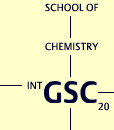


![]()
Name: Marc Dierksen
Diploma / M.Sc degree: Westfälische Wilhelms-Universität, Münster,
Germany
(May 2003)
PhD Project: Efficent calculation of the vibronic structure of electronic spectra
using density functional methods
Homepage:
http://www.uni-muenster.de./Chemie/OC/research/grimme/dierksen.html
Abstract of Research Project
Since the early work of Franck and Condon (1925/26) the vibronic structure of electronic absorption and
emission spectra of molecules has been extensively investigated.
Sophisticated experimental techniques like laser induced fluorescence (LIF), resonance two photon
ionisation (R2PI) and dispersed fluorescence (DF) spectroscopy combined with an effective cooling
in a supersonic jet expansion or a matrix permit the measurement of the vibronic structure with very high
resolution. This provides valuable insights into the structural changes accompanied with the electronic
transition as well as information about the vibrational modes of the electronic states involved in the
transition and vibronic coupling effects induced by these modes. For larger molecules the extraction of
this information from the spectra alone is hopelessly complicated and therefore several attempts
for theoretical simulations of the vibronic structure have been made. Additionally, from the theoretical
point of view the comparision of simulations and experiment permits an indirect quality assessment
for the theoretical method used. Recently,
it has been shown [1] that a simulation of the vibronic stucture using density functional methods
(DFT/TDDFT-B3LYP) yields very good results for strongly dipole allowed transitions employing the
Franck-Condon approximation. However, for weakly dipole allowed and dipole forbidden transitions,
simulations based on TDDFT calculations seem to be problematic due to relatively large errors of
TDDFT for the relative energies of different excited electronic states.
In my PhD thesis it is planned to develop and implement computational strategies which routinely allow
vibronic structure calculations for large molecules, for example organic dyes and biological chromophores.
Futhermore I will investigate the application of more sophisticated theoretical methods for the simulation
of the vibronic structure of weakly dipole allowed and dipole forbidden transitions. Additionally,
vibronic effects in circular dichroism (CD) spectra will be examined and a simulation of the CD spectra
of molecules with isotopically engendered chirality will be attempted.
Publications
M. Dierksen, S. Grimme
A theoretical study of the chiroptical properties of molecules with isotopically engendered chirality
J. Chem. Phys. , 124 (2006), 174301.
M. Dierksen, S. Grimme
An efficient approach for the calculation of Franck-Condon integrals of large molecules
J. Chem. Phys. , 122 (2005), 244101-244101-9.
M. Dierksen, S. Grimme
Density Functional Calculations of the Vibronic Structure of Electronic Absorption Spectra
J. Chem. Phys. , 120 (2004), 3544-3554.
M. Dierksen, S. Grimme
The Vibronic Structure of Electronic Absorption Spectra of Large Molecules: A Time-Dependent Density Functional Study on the Influence of "Exact" Hartree-Fock Exchange
J. Phys. Chem. , 108 (2004), 10225-10237.
Marc Dierksen
eMail: dierksen@uni-muenster.de